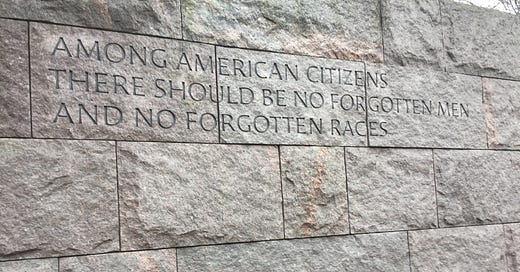On April 12, 1945, a visibly exhausted President Franklin Delano Roosevelt jerked in his chair while having his portrait painted in Warm Springs, Georgia. FDR put his hand up, said “I have a terrific pain in the back of my head,” and lost consciousness. He died of a massive cerebral hemorrhage within hours.
When FDR entered the White House in 1933, he undertook to rebuild the nation after Republicans had run it into the ground.
Believing that businessmen were the engine that drove the economy and that any government regulations or taxes that hampered them would hurt growth, Republicans under presidents Warren G. Harding, Calvin Coolidge, and Herbert Hoover had slashed taxes and regulations. The superheated economy boomed, but real wages stagnated, and the profits from dramatically improved production all went to the top 1% of the economy.
When spokespeople tried to point out that the new economy shut farmers, immigrants, and minorities out, Republicans accused those groups of falling behind because they were lazy. But then, in October 1929, the stock market crashed and the Roaring Twenties stopped dead. People lost their jobs, their homes, and their hope.
In the presidential election of 1932, desperate voters threw the Republicans out of office and put in Democrats, led by former New York Governor Franklin Delano Roosevelt. FDR recognized that the economic crisis created by unfettered capitalism threatened to end democracy forever as starving Americans turned either to communism or to fascism, as Europeans were doing.
FDR understood that to preserve democracy and the economic system on which it rested, the government must regulate business, protect workers, and provide a basic social safety net. His "New Deal for the American people" did exactly that, and it helped Americans weather the Depression until the extraordinary deficit spending of WWII ended it altogether.
Ordinary Americans celebrated a government that worked for everyone, rather than just the rich. And on April 13, they mourned the man who had piloted the country through that transition.
[Image from the FDR Memorial, Washington, D.C.]



Good morning, Professor! This is exactly what Biden is trying to do, bring everyone together, create jobs (which he’s done), stimulate the economy, in spite of inflation which he nor the Dems are responsible for. He has called out the world’s biggest enemy as a murderer, creating genocide. He is absolutely correct. I used to get mad at him for being what I thought was a loose cannon, when he spoke. I do not think that anymore. He is our century’s replica of FDR. He is juggling buckets of issues and is doing it quite well. Thank you for showing the words at FDR’s memorial. I take that to heart.
I have always found it intriguing that FDR, who by upbringing and socioeconomic background would clearly „belong“ to the Republican party (a „trust fund kid“ if there ever was one), would become the beacon of Social Democracy (which is the political science designation anywhere in the world but the USA).
From reading many biographies, I see three factors:
1. Social Democracy - the „New Deal“, as he labeled it - was REASON‘s solution for the problems before him
2. Eleanor, his wife, influenced him deeply in this regard. FDR realized there could not be a just society in the spirit of the US Declaration of Independence and Constitution without equal rights for women (I do not know enough about his personal theory for the suppression of non-whites)
3. POLIO, which struck him as a grown-up, was THE major educational influence on him. While he was arrogant and light-headed before, polio made him humble about every facet of his life.